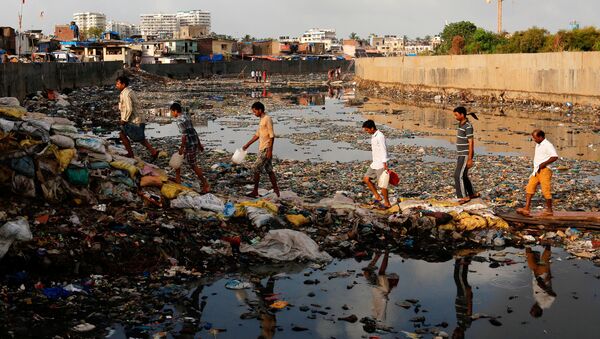New Delhi (Sputnik) – Economists Praveen Chakravarty and Vivek Dehejia acquired images grabbed by satellites from the US Air Force Defense Meteorological Satellite and superimposed a map of India with its districts clearly bifurcated on the image to develop a unique data set of luminosity values district-wise over a period of time to get the results.
These satellites whose images have been used for the research circle the earth 14 times a day and record lights from the earth's surface at night with sensors.
READ MORE: Delhi to Overtake Tokyo to Become World's Most Populous City by 2028 — UN Report
The two Indian economists studied 387 of 640 districts in 12 states of India. These districts in total account for 85% of India's population and 80% of its GDP. With the study, the economists documented income divergence in India.
By 2014, the economists found, the average person in the three richest states (Kerala, Tamil Nadu, Maharashtra) was three times as rich as the average person in the three poorest states (Bihar, Uttar Pradesh, and Madhya Pradesh), the AFP reported.
#Inequality in #India documented from outer space: From 1991 to 2014, the average person in 3 richest states (Kerala, Tamil Nadu, Maharashtra) became 3 times as rich as average person in 3 poorest states (Bihar, Uttar Pradesh and Madhya Pradesh)https://t.co/2ysNLxg4sI pic.twitter.com/ZaeNQLtTnF
— Assaad Razzouk (@AssaadRazzouk) May 27, 2018
Thrilled to see groundbreaking research by @pravchak @vdehejia using night lights satellite data to document skyrocketing regional inequality in India. Creating quite a buzz in development policy circles. https://t.co/3KUsPsSDP8
— Rupa Subramanya (@rupasubramanya) May 27, 2018
There are many who have challenged the study. Member of Parliament and former Indian UN diplomat Shashi Tharoor tweeted saying that at night there is no economic activity.
Fascinating: what looking at India from space, at night, teaches us! Most of India is dark at night because there is little economic activity going on. But lights seen from space also show that States are becoming more unequal between&within them: https://t.co/iMwrfkbzNv
— Shashi Tharoor (@ShashiTharoor) May 27, 2018
Rural areas are not densely populated and hence the study's premise is wrong, argued another Twitter user.
Inequality in India can be seen from outer space. The authors should study urbanisation to come to a conclusion on inequality! Rural areas with thin population will always have lesser light’s at night @pravchak https://t.co/CgpMFQVnMb
— Mohandas Pai (@TVMohandasPai) May 27, 2018



